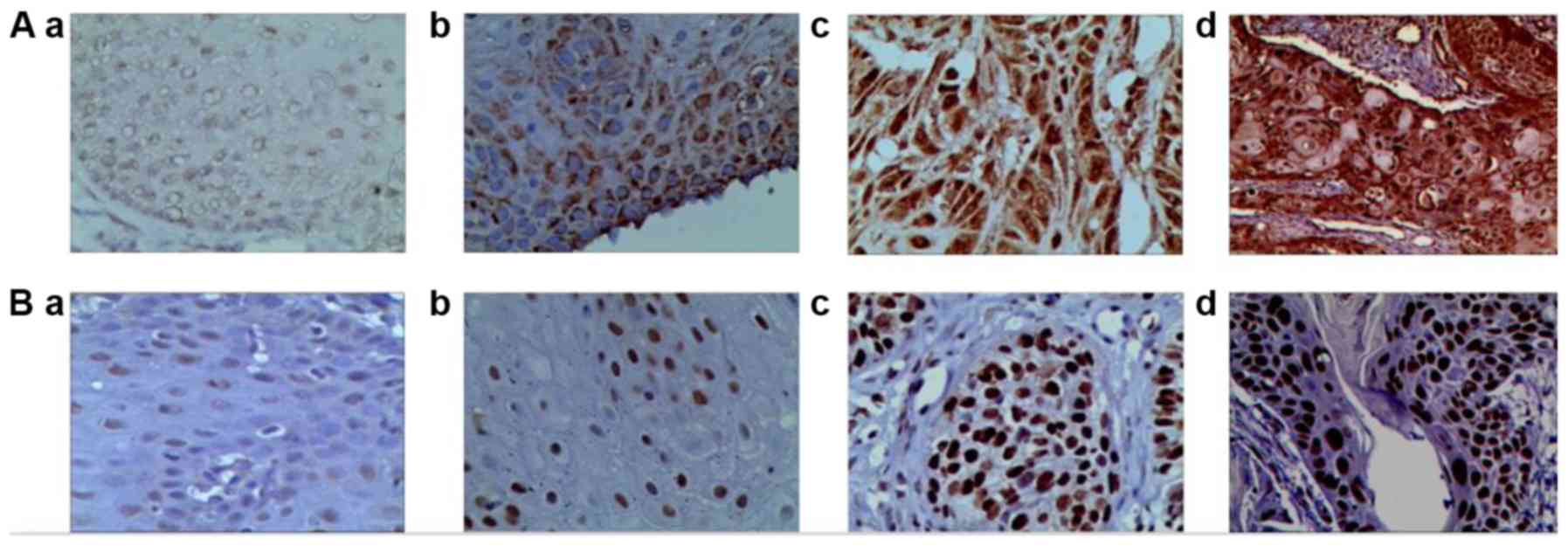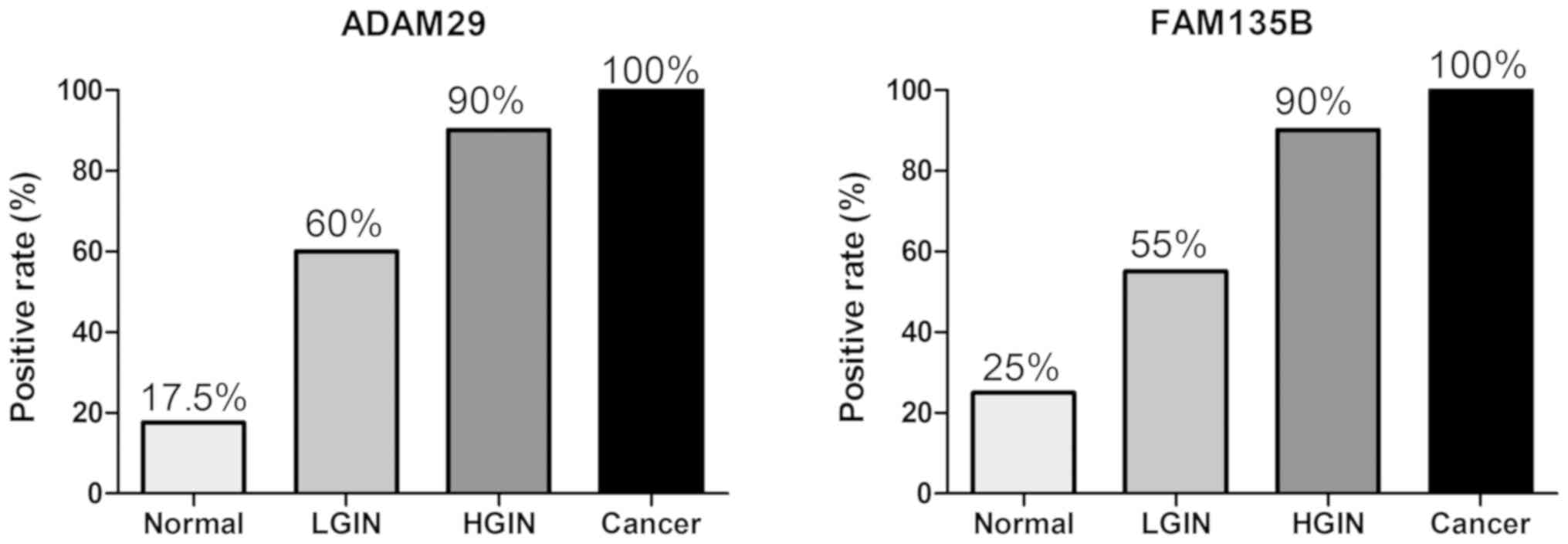|
1
|
Bray F, Ferlay J, Soerjomataram I, Siegel
RL, Torre LA and Jemal A: Global cancer statistics 2018 GLOBOCAN
estimates of incidence and mortality worldwide for 36 cancers in
185 countries. CA Cancer J Clin. 68:394–424. 2018. View Article : Google Scholar : PubMed/NCBI
|
|
2
|
Wei KR, Lian QH, Liu J and Liang ZH:
Prevalence of esophageal cancer. Chin J Int Med. 51:156–158.
2012.(In Chinese).
|
|
3
|
Malhotra GK, Yanala U, Ravipati A, Follet
M, Vijayakumar M and Are C: Global trends in esophageal cancer. J
Surg Oncol. 115:564–579. 2017. View Article : Google Scholar : PubMed/NCBI
|
|
4
|
Torre LA, Bray F, Siegel RL, Ferlay J,
Lortet-Tieulent J and Jemal A: Global cancer statistics, 2012. CA
Cancer J Clin. 65:87–108. 2015. View Article : Google Scholar : PubMed/NCBI
|
|
5
|
Zhang Y: Epidemiology of esophageal
cancer. World J Gastroenterol. 19:5598–5606. 2013. View Article : Google Scholar : PubMed/NCBI
|
|
6
|
Zhou MG, Wang XF, Hu JP, Li GL, Chen WQ,
Zhang SW, Wan X, Wang LJ, Xiang C, Hu YS and Yang GH: Geographical
distribution of cancer mortality in China, 2004–2005. Zhonghua Yu
Fang Yi Xue Za Zhi. 44:303–308. 2010.(In Chinese). PubMed/NCBI
|
|
7
|
Li QW, Yuan GJ, Du YX, Pan CN and He Y:
Analysis of the prevalence and treatment of esophageal cancer in
huai an area. J Clin Oncol. 17:142–145. 2012.
|
|
8
|
Siegel R, Naishadham D and Jemal A: Cancer
statistics, 2012. CA Cancer J Clin. 62:10–29. 2012. View Article : Google Scholar : PubMed/NCBI
|
|
9
|
Wang GQ, Jiao GG, Chang FB, Fang WH, Song
JX, Lu N, Lin DM, Xie YQ and Yang L: Long-term results of operation
for 420 patients with early squamous cell esophageal carcinoma
discovered by screening. Ann Thorac Surg. 77:1740–1744. 2004.
View Article : Google Scholar : PubMed/NCBI
|
|
10
|
Aminian A, Panahi N, Mirsharifi R,
Karimian F, Meysamie A, Khorgami Z and Alibakhshi A: Predictors and
outcome of cervical anastomotic leakage after esophageal cancer
surgery. J Cancer Res Ther. 7:448–453. 2011. View Article : Google Scholar : PubMed/NCBI
|
|
11
|
Wang GQ, Zhang YM and He S: Present
situation and prospect of diagnosis and treatment of early
esophageal cancer and precancerous lesions in China. Chin Cancer.
18:690–694. 2009.(In Chinese).
|
|
12
|
Siewert JR and Ott K: Are squamous and
adenocarcinomas of the esophagus the same disease. Semin Radiat
Oncol. 17:38–44. 2007. View Article : Google Scholar : PubMed/NCBI
|
|
13
|
Hao J and Shao K: Epidemiological status,
diagnosis and treatment of esophageal cancer in China and China's
future countermeasures. Chin J Cancer. 501–504. 2011.(In
Chinese).
|
|
14
|
Song Y, Li L, Ou Y, Gao Z, Li E, Li X,
Zhang W, Wang J, Xu L, Zhou Y, et al: Identification of genomic
alterations in oesophageal squamous cell cancer. Nature. 509:91–95.
2014. View Article : Google Scholar : PubMed/NCBI
|
|
15
|
Cerretti DP, DuBose RF, Black RA and
Nelson N: Isolation of two novel metalloproteinase-disintegrin
(ADAM) cDNAs that show testis-specific gene expression. Biochem
Biophys Res Commun. 263:810–815. 1999. View Article : Google Scholar : PubMed/NCBI
|
|
16
|
Edwards DR, Handsley MM and Pennington CJ:
The ADAM metalloproteinases. Mol Aspects Med. 29:258–289. 2008.
View Article : Google Scholar : PubMed/NCBI
|
|
17
|
Wang F, Xu R, Zhu P, Hu J, Ying B, Zhao S
and Li C: Preliminarily functional analysis of a cloned novel human
gene ADAM29. Sci China C Life Sci. 44:392–399. 2001. View Article : Google Scholar : PubMed/NCBI
|
|
18
|
Oria VO, Lopatta P, Schmitz T, Preca BT,
Nyström A, Conrad C, Bartsch JW, Kulemann B, Hoeppner J, Maurer J,
et al: ADAM9 contributes to vascular invasion in pancreatic ductal
adenocarcinoma. Mol Oncol. 13:456–479. 2019. View Article : Google Scholar : PubMed/NCBI
|
|
19
|
Luo ML, Zhou Z, Sun LC, Sun L, Yu L, Sun
L, Liu J, Yang Z, Ran Y, Yao Y and Hu H: An ADAM12 and FAK positive
feedback loop amplifies the interaction signal of tumor cells with
extracellular matrix to promote esophageal cancer metastasis.
Cancer Lett. 422:118–128. 2018. View Article : Google Scholar : PubMed/NCBI
|
|
20
|
Li W, Wang D, Sun X, Zhang Y, Wang L and
Suo J: ADAM17 promotes lymph node metastasis in gastric cancer via
activation of the Notch and Wnt signaling pathways. Int J Mol Med.
43:914–926. 2019.PubMed/NCBI
|
|
21
|
Mochizuki S and Okada Y: ADAMs in cancer
cell proliferation and progression. Cancer Sci. 98:621–628. 2007.
View Article : Google Scholar : PubMed/NCBI
|
|
22
|
Zhang B, Li Y, Li L, Chen M, Zhang C, Zuo
XB, Zhou FS, Liang B, Zhu J, Li P, et al: Association study of
susceptibility loci with specific breast cancer subtypes in Chinese
women. Breast Cancer Res Treat. 146:503–514. 2014. View Article : Google Scholar : PubMed/NCBI
|
|
23
|
Shan Q, Lou X, Xiao T, Zhang J, Sun H, Gao
Y, Cheng S, Wu L, Xu N and Liu S: A cancer/testis antigen
microarray to screen autoantibody biomarkers of non-small cell lung
cancer. Cancer Lett. 328:160–167. 2013. View Article : Google Scholar : PubMed/NCBI
|
|
24
|
Costa NR, Paulo P, Caffrey T,
Hollingsworth MA and Santos-Silva F: Impact of MUC1 mucin down
regulation in the phenotypic characteristics of MKN45 gastric
carcinoma cell line. PLoS One. 6:e269702011. View Article : Google Scholar : PubMed/NCBI
|
|
25
|
Brim H, Abu-Asab MS, Nouraie M, Salazar J,
Deleo J, Razjouyan H, Mokarram P, Schaffer AA, Naghibhossaini F and
Ashktorab H: An integrative CGH, MSI and candidate genes
methylation analysis of colorectal tumors. PLoS One. 9:e821852014.
View Article : Google Scholar : PubMed/NCBI
|
|
26
|
Wei X, Moncada-Pazos A, Cal S,
Soria-Valles C, Gartner J, Rudloff U, Lin JC; NISC Comparative
Sequencing Program, ; Rosenberg SA, López-Otín C and Samuels Y:
Analysis of the disintegrin-metalloproteinases family reveals
ADAM29 and ADAM7 are often mutated in melanoma. Hum Mutat.
32:E2148–E2175. 2011. View Article : Google Scholar : PubMed/NCBI
|
|
27
|
Oki NO, Motsinger-Reif AA, Antas PR, Levy
S, Holland SM and Sterling TR: Novel human genetic variants
associated with extrapulmonary tuberculosis A pilot genome wide
association study. BMC Res Notes. 4:282011. View Article : Google Scholar : PubMed/NCBI
|
|
28
|
Zhou C, Ye M, Ni S, Li Q, Ye D, Li J, Shen
Z and Deng H: DNA methylation biomarkers for head and neck squamous
cell carcinoma. Epigenetics. 13:398–409. 2018. View Article : Google Scholar : PubMed/NCBI
|
|
29
|
Rice TW: Esophageal cancer staging. Korean
J Thorac Cardiovasc Surg. 48:157–163. 2015. View Article : Google Scholar : PubMed/NCBI
|
|
30
|
Rice TW, Rusch VW, Ishwaran H and
Blackstone EH; Worldwide Esophageal Cancer Collaboration, : Cancer
of the esophagus and esophagogastric junction Data-driven staging
for the seventh edition of the American joint committee on
cancer/international union against cancer staging manuals. Cancer.
116:3763–3773. 2010. View Article : Google Scholar : PubMed/NCBI
|
|
31
|
Edge SB, Byrd DR, Compton CC, et al: AJCC
cancer staging manual. 7th. Springer; New York, NY: 2010
|
|
32
|
Zhou ZJ, Xie JL, Wei P and Zhou XG:
Pathologic subtyping of primary lymphoma of breast and prognostic
analysis. Zhonghua Bing Li Xue Za Zhi. 46:618–622. 2017.(In
Chinese; Abstract available in Chinese from the publisher).
PubMed/NCBI
|
|
33
|
Seals DF and Courtneidge SA: The ADAMs
family of metalloproteases: Multidomain proteins with multiple
functions. Genes Dev. 17:7–30. 2003. View Article : Google Scholar : PubMed/NCBI
|
|
34
|
Rocks N, Paulissen G, El Hour M, Quesada
F, Crahay C, Gueders M, Foidart JM, Noel A and Cataldo D: Emerging
roles of ADAM and ADAMTS metalloproteinases in cancer. Biochimie.
90:369–379. 2008. View Article : Google Scholar : PubMed/NCBI
|
|
35
|
Noël A, Gutiérrez-Fernández A, Sounni NE,
Behrendt N, Maquoi E, Lund IK, Cal S, Hoyer-Hansen G and López-Otín
C: New and paradoxical roles of matrix metalloproteinases in the
tumor microenvironment. Front Pharmacol. 3:1402012. View Article : Google Scholar : PubMed/NCBI
|
|
36
|
Lu X, Lu D, Scully M and Kakkar V: ADAM
proteins-therapeutic potential in cancer. Curr Cancer Drug Targets.
8:720–732. 2008. View Article : Google Scholar : PubMed/NCBI
|
|
37
|
Murphy G: The ADAMs Signalling scissors in
the tumour microenvironment. Nat Rev Cancer. 8:929–941. 2008.
View Article : Google Scholar : PubMed/NCBI
|
|
38
|
Maloum K, Settegrana C, Chapiro E, Cazin
B, Leprêtre S, Delmer A, Leporrier M, Dreyfus B, Tournilhac O, Mahe
B, et al: IGHV gene mutational status and LPL/ADAM29 gene
expression as clinical outcome predictors in CLL patients in
remission following treatment with oral fludarabine plus
cyclophosphamide. Ann Hematol. 88:1215–1221. 2009. View Article : Google Scholar : PubMed/NCBI
|
|
39
|
Quilter CR, Sargent CA, Bauer J, Bagga MR,
Reiter CP, Hutchinson EL, Southwood OI, Evans G, Mileham A, Griffin
DK and Affara NA: An association and haplotype analysis of porcine
maternal infanticide A model for human puerperal psychosis. Am J
Med Genet B Neuropsychiatr Genet. 159:908–927. 2012. View Article : Google Scholar
|
|
40
|
Tsang KM, Croen LA, Torres AR, Kharrazi M,
Delorenze GN, Windham GC, Yoshida CK, Zerbo O and Weiss LA: A
genome-wide survey of transgenerational genetic effects in autism.
PLoS One. 8:e769782013. View Article : Google Scholar : PubMed/NCBI
|
|
41
|
Lin JQ, Huang ZJ, Chen ZR, et al:
Relationship between FAM135B gene and lymph node metastasis of
esophageal squamous cell carcinoma. Chin J Exp Surg. 6:1170–1171.
2018.(In Chinese).
|
|
42
|
Dong DZ: The Function and Mechanism of
FAM135B in the Deveopment of esophageal squamous cell carcinoma
(unpublished PhD thesis). Peking Union Medical College; 2018
|
















